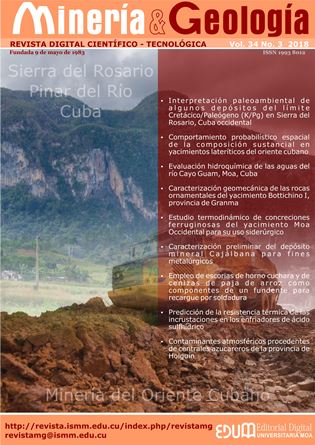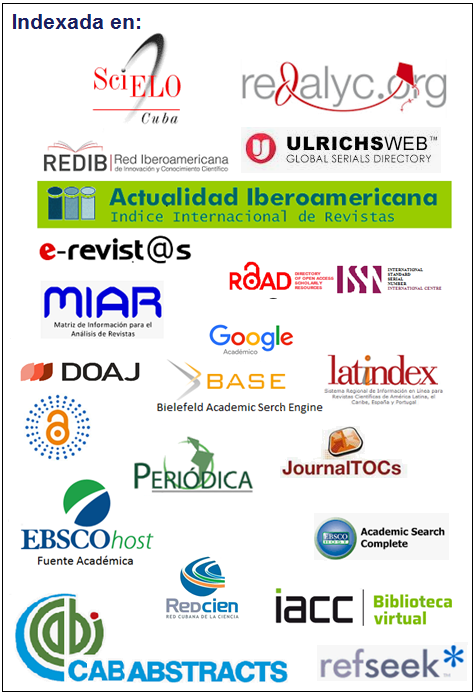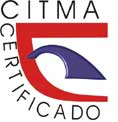Prediction of the fouling thermal resistance on the sulphydric acid coolers
Keywords:
fouling, heat exchanger, hydrogen sulphide, multivariable linear regression, artificial neural networks.Abstract
Heat exchangers’ fouling causes increased resistance to thermal exchange, with subsequent efficiency loss. Although related analysis has been exposed in previous studies, the available mathematical models do not consider all forms and mechanisms of deposition of unwanted material. This investigation proposed two models for prediction of the fouling thermal resistance in a system of hydrogen sulphide gas coolers under operations. The values for independent and response variables inherent to the process were obtained by applying the passive experimentation method. Correlations of 98,07 % and 97,23 % were achieved from the multivariable regression model (for the tubeside-shellside heat exchange and the shellside-jacket interaction, respectively), as compared to 99,63 and 99,03 % for the artificial neural network. The results confirm the validity of both techniques as reliable forecasting tools, with the neural network being the best predictor.Downloads
References
Al-Hallaf, W. A. A. 2013: Theoretical study on heat transfer in the presence of fouling. Iraqui Journal of Chemical and Petroleum Engineering, 14(1): 47-53.
Al-Zwainy, F. M. S.; Abdulmajeed, M. H. y Maljumaily, H. S. 2013: Using Multivariable Linear Regression technique for modeling productivity construction in Iraq. Open Journal of Civil Engineering, 3(3): 127-135.
Ardsomang, T.; Hines, J. W. y Upadhyaya, B. R. 2013: Heat exchanger fouling and estimation of remaining useful life. En: Proceedings of the Annual Conference of Prognostics and Health Management Society. Actas de Conferencias. Knoxville, Estados Unidos, 1-9.
Coletti, F.; Diaz-Bejerano, E.; Martínez, J. y Macchietto, S. 2015: Heat exchanger design with high shear stress: reducing fouling or throughput. En: International Conference on Heat Exchanger Fouling and Cleaning. Actas de Conferencias. Enfield, Irlanda, 27-33.
Cosic, P.; Lisjak, D. y Antolic, D. 2011: Regression analysis and Neural Networks as methods for production time estimation. Tehnicki vjesnik, 18(4): 479-484.
Gerami, A. y Darvishi, P. 2014: Modeling of the deposit formation on shell and tube heat exchanger of Hasheminejad Gas Refinery Plant. Indian Journal of Scientific Research, 5(1): 382-388.
Ghiasi, M. M.; Bahadori, M.; Lee, M.; Kashiwao, T. y Bahadori, A. 2016: Rapid prediction of Prandtl number of compressed air. Chemical Engineering, 123(6): 52-58.
Ghiwala, T. M. y Matawala, V. K. 2014: Sizing of triple concentric pipe heat exchanger. International Journal of Engineering Development and Research, 2(2): 1683-1692.
Harris, J. S. 2014: The interpretation of fouling data from a Stirred Batch Cell. Tesis de maestría. University of Bath. 145 p.
Hernández-Sampieri, R.; Fernández-Collado, C. y Baptista-Lucio, M. P. 2010: Metodología de la investigación. 5ta ed. México D. F.: McGraw-Hill. 613 p.
Iyengar, A. S. 2015: Thermal analysis of shell and tube heat exchanger using artificial neural networks. Ethiopian Journal of Science and Technology, 8(2): 207-120.
Jaglarz, G. y Taler, D. 2015: Experimental study of fouling in plate heat exchangers in district heating systems. Journal of Power Technologies, 95(5): 42-46.
Kakac, S. y Liu, H. 2002: Heat exchangers. Selection, rating and thermal design. 2da ed. Nueva York: CRC Press. 491 p.
Kamble, L. V.; Pangavhane, D. R. y Singh, T. P. 2014: Heat transfer studies using Artificial Neural Networks - A review. International Energy Journal, 14: 25-42.
Kaneko, H.; Inasawa, S.; Inokuchi, H. y Funatsu, K. 2009: Construction of high predictive fouling models using statistical methods. En: International Conference on Heat Exchanger Fouling and Cleaning. Actas de Conferencias, vol. VIII. Schladming, Austria, 260-262.
Kashani, M. N.; Aminian, J.; Shahhosseini, M. y Farrokhi, M. 2012: Dynamic crude oil fouling prediction in industrial preheaters using optimized ANN based moving window technique. Chemical Engineering Research and Design, 90(7): 938-949.
Kerner, J. 2011: Compact, high-efficiency heat exchangers: understanding fouling. Chemical Engineering, 118(6): 35-41.
Li, Q.; Liu, C. y Zhang, Z. 2014: Prediction of Solubility of Sulphur in Hydrogen Sulphide Based on Molecular Dynamics Simulation. Asian Journal of Chemistry, 26(4): 1041-1043.
Moghadassi, A. R.; Hosseini, S. M.; Parvizian, F.; Mohamadiyon, F.; Behzadi-Moghadam, A. y Saneirad, A. 2011: An expert model for the shell and tube heat exchangers analysis by Aritificial Neural Networks. ARPN Journal of Engineering and Applied Sciences, 6(9): 78-93.
Mohanraj, M.; Jayaraj, S. y Muraleedharan, C. 2015: Application of artificial neural networks for thermal analysis of heat exchangers - A review. International Journal of Thermal Sciences, 90: 150-172.
Molina-Pérez, H.; Cano-Gómez, J. J.; Díaz-Ovalle, C. O. y Castillo-Borja, F. 2015: Equivalencia del espesor de ensuciamiento con -lg desnaturalizada en el calentamiento de leche. Avances en Ciencias e Ingeniería, 6(1): 49-62.
Mukherjee, R. 2004. Practical thermal design of shell-and-tube heat exchangers. Nueva York: Begell House Inc. 228 p.
Navarro, O. 2009. Selección de variables en regresión Componentes principales. En: 7th Latin American and Caribbean Conference for Engineering and Technology. Actas de Conferencias. San Cristóbal, Venezuela, 2-5 junio, 1-8.
Pacheco-Bonrostro, J. y Casado-Yusta, S. 2007: Algoritmos meméticos para selección de variables en el análisis discriminante. Estadística Española, 49(165): 333-347.
Sánchez-Escalona, A. A.; Góngora-Leyva, E.; Zalazar-Oliva, C. y Álvarez-Hernández, E. 2017: Análisis del intercambio de calor e incrustaciones en un sistema de enfriadores de ácido sulfhídrico. Minería y Geología, 33(3): 326-340.
Torres-Tamayo, E.; Quintana-Charlot, L. E.; Vega-Árias, O. y Retirado-Mediaceja, Y. 2011: Coeficientes de transferencia de calor y pérdida de eficiencia en intercambiadores de calor de placas durante el enfriamiento del licor amoniacal. Minería y Geología, 27(2): 67-83.
Torres-Tamayo, E.; Retirado-Medianeja, Y. y Góngora-Leyva, E. 2014: Coeficientes de transferencia de calor experimental para el enfriamiento de licor en intercambiadores de placas. Ingeniería Mecánica, 17(1): 68-77.
Published
How to Cite
Issue
Section
- Authors retain copyright and guaranteeing the right magazine to be the first publication of the work as licensed under a Creative Commons Attribution-NonCommercial that allows others to share the work with an acknowledgment of the work's authorship and initial publication in this journal.
- Authors may establish separate supplemental agreements for the exclusive distribution version of the work published in the journal (eg, place it in an institutional repository or publish it in a book), with an acknowledgment of its initial publication in this journal.
- Authors are allowed and recommended to disseminate their work through the Internet (e.g., in institutional telematic archives or on their websites) before and during the submission process, which can produce interesting exchanges and increase citations of the published work. (See The effect of open access)




